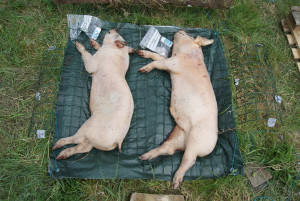Identifying the ‘smell of death’

Most people are able to recognise the smell of “death” when they encounter a dead animal on a farm or a roadkill. But despite its distinctive scent, few know why it actually smells the way it does. Even forensic scientists may not have identified all of the compounds behind it yet – they are still in the process.
Understanding the pattern of change of the chemicals that make up the scent during the process of decomposition could be of huge benefit to forensic science. Not only could it help determine the time of death of a victim, it could also lead to more scientifically rigorous training of cadaver dogs.
A symphony of scents
The smell of death is a very complex symphony of scents, with different notes waxing and waning as decomposition progresses. To date, more than 480 different volatile organic compounds (VOCs) have been captured and identified from human cadavers, and more than 800 have been identified from porcine (pig) cadavers.

Dr Anna Williams at the University of Huddersfield, and her team Lorna Irish and Dr Gareth Parkes, have identified hundreds of chemicals given off by decomposing pig cadavers, both on land and under water. Porcine cadavers are frequently used for forensic research in the UK because of their physiological similarities to humans and the relative ease of obtaining them. There is currently no way for researchers to access human remains for this purpose, such as dedicated taphonomy facilities or “body farms”.
The different stages of decomposition
The research carried out by Dr Williams and her team used fluffy fibres to capture the gases given off by porcine cadavers enclosed in boxes, lying in air and in water, over a period of time. A gas chromatography mass spectrometry (GCMS) was used to identify the individual volatile organic compounds absorbed by the fibres.
Surprisingly, some of the gases that make up the whole bouquet of death were actually quite pleasant – including hexanal and butanol. Hexane is associated with the smell of freshly-mown grass and butanol smells of leaf litter and forest floors. These are present in the earliest stages of decomposition and then reappear in the very final stage, known as skeletonisation.
Some of the worst smells come somewhere in the middle of the decomposition process. Chemicals released during the bloat stage, which occurs about a week after death (depending on the surrounding conditions), when intestinal bacteria are reproducing.
By the time skeletonisation occurs, the odour-producing bacteria have been replaced by more mechanical means of decay, and the obnoxious smells are replaced by more woody, wet notes.
Future applications
Understanding the rhythm, rise and fall of these fragrant notes allows forensic scientists to attempt to decipher the “magic formula” that specially-trained cadaver dogs are looking for.
In the future, it may be possible to use the various scents given off by a cadaver to determine cause of death, as some medical conditions may encourage certain bacterial growth. Analysing the volatile organic compounds could provide a more reliable way of estimating the time that has elapsed since a person has died – the post-mortem interval.
Based on Williams, A. (2015) The smell of death: its chemical pattern could become a powerful forensic tool. The Conversation, 25 September 2015

Spotlight
Dr Anna Williams
Dr Anna Williams, University of Huddersfield, is Principal Enterprise Fellow in Forensic Anthropology. She leads the Forensic Anthropology Research Group at the University of Huddersfield, lectures on undergraduate and postgraduate forensic courses and supervises MSc and PhD students. Her main area of research is decomposition and taphonomy – understanding how a body decomposes in a variety of environments. This is important for improving the estimation of time since death and for identifying unknown remains. Dr Williams is an experienced Forensic Anthropologist with considerable casework experience. She regularly undertakes consultancy work for police forces, Kenyon International Emergency Services and Forensic Engineering Solutions. She is also very active in public engagement. She regularly presents at science festivals, is often seen on TV science documentaries, writes for popular science journals such as New Scientist, and advises for TV shows such as Bones and Silent Witness. Find out more on her blog: www.forensicanna.com To find out more about the research in this article, please contact Dr Anna Williams: A.Williams@hud.ac.uk
Autumn 2016 Issue
Return to the home page for the Autumn 2016 Issue of Discover.
Next article
The critical role of voice evidence in court. Forensic speaker comparison involves the comparison of criminal recording, for example...